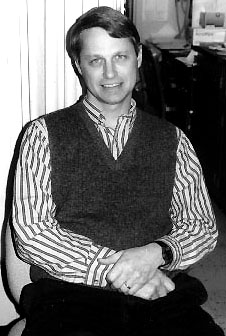
| T H E N I H C A T A L Y S T | M A R C H – A P R I L 1997 |
|
|
|
BRAINCHILD WITHOUT PATENTYIELDS ANYBODY'S ANTIBODIES |
by Fran Pollner |
 |
|
Bob Wenthold
|
Bob Wenthold's Laboratory of Neurochemistry at NIDCD was one of the first three labs, in 1989, to clone a member of the brain's ubiquitous glutamate receptor family. In 1990, Wenthold made the first antibodies to these receptors—a feat that coupled his name with "neurotransmitter antibodies" on the exclusive list of commercialized NIH inventions that attracted more than $100,000 in annual sales in 1995 (see "NIH Inventions Chart"). Unlike many NIH inventions, however, this one became a commercial success without benefit of patent.
Instead, the NIH Office of Technology Transfer (OTT) negotiated a nonexclusive license with a private partner, and Wenthold's antibodies went on the market at a relatively modest price.
Wherein, then, lies the product's commercial cachet? "Essentially every neuron in the brain expresses at least one of these receptors, and most express many. So anybody studying any aspect of the brain is going to be interested in glutamate receptors," says Wenthold. Not only is glutamate the major excitatory neurotransmitter, he points out, but it's also neurotoxic in excess, figures in current models of learning and memory, and has relevance to the auditory system, which is why his lab was studying it in the first place. "And you cannot study the protein directly if you just have the structure of the gene; you can only project," he says. What's needed to study the way the protein works are antibodies to specific parts of the glutamate receptors, which is what his lab made.
"And we got lucky," he adds. "It's not always the case that the antibodies work, but we obtained a number that worked very well for us—and for many other people. An antibody is an extremely useful reagent, and they're often hard to come by. You write people, begging for antibodies, and if you're lucky, you get them. We published a first little paper in 1990, and a major one in 1992, and I started getting hundreds of requests because it's much better to get a proven antibody from somebody else than to try to make it yourself. We sent out some, but we just couldn't keep up."
Licensing the product to a private partner through the OTT was the obvious way to go, and although ensuring the quality of the new product was more time-consuming and painstaking than he'd anticipated, eventually "things smoothed out, the product became widely available, and it's helped the field a lot."
It also helped his lab, Wenthold says, searching his computer screen for a record of items bought with the royalties the laboratory received. "Most of the NIH portion of the royalties comes back to the lab here. I think that varies from institute to institute, at the scientific director's discretion . . . but in our case, it comes back here, and that's been very useful. Just last year, we got some equipment for anatomical studies we couldn't have gotten before—to localize receptors by freeze substitution using colloidal gold. It looks like over $30,000 went to that."
But Wenthold considers 1995 an "unusual" year—the first year the product was "really out there and with no competition." He predicts that royalties will diminish now that about a dozen companies are filling the market with rival products. Since the license is nonexclusive, however, collaborative arrangements with other companies could also be in the offing for his lab, which, Wenthold notes, would spread not only the wealth but the science, "which should be the way science is done, especially at NIH."
As for his personal portion
of that wealth, "it hasn't been that much. I didn't trade in my Honda for
a Mercedes, or anything like that," he says. His own research on the distribution
of glutamate receptors and the regulation of their expression continues, uninfluenced
by the lure of further commercial potential. ![]()